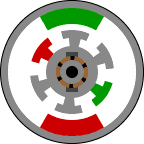 |
Many people are familar with DC motors.
If you have ever had a electric toy train or car as
a child, you may know how a DC motor works. If you were
like me you probably took one apart and couldn't put
it back together. Usually the brush springs get lost.
The stator is the stationary outside part
of a motor. The rotor is the inner part which
rotates. In the motor animations, red
represents a magnet or winding with a north polarization,
while green represents
a magnet or winding with a south polarization.
Opposite, red and
green, polarities attract.
The stator of a permanent magnet dc motor is composed
of two or more permanent magnet pole pieces.
|
The rotor
is composed of windings which are connected to a mechanical
commutator. In this case the rotor has three pole
pairs. The opposite polarities of the energized winding
and the stator magnet attract and the rotor will rotate
until it is aligned with the stator. Just as the rotor
reaches alignment, the brushes move across the commutator
contacts and energize the next winding. In the animation
the commutator contacts are brown and the brushes
are dark grey. A yellow spark shows when the brushes
switch to the next winding.
Notice that the comutator is staggered from the
rotor poles. If the connections of a dc motor are
reversed the motor will change directions. Though
it will not always work as well in both directions.
This is a permanent magnet dc motor.

Two other types
of dc motors are series wound and shunt
wound dc motors. These motors also use a similar
rotor with brushes and a commutator. However, the
stator uses windings instead of permanent magnets.
The basic principle is still the same. A series wound
dc motor has the stator windings in series with the
rotor. A shunt wound dc motor has the stator windings
in parallel with the rotor winding. The series wound
motor is more common. A series wound motor is also
called a universal motor. It is universal
in the sense that it will run equally well using either
an ac or a dc voltage source. Reversing the polarity
of both the stator and the rotor cancel out. Thus
the motor will always rotate the same direction irregardless
of the voltage polarity. A universal motor is in a
sense an ac motor in that it will operate from an
ac power source. I prefer the term universal motor
to avoid confusion with ac induction motors.
|